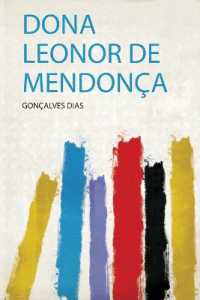- ホーム
- > 洋書
- > 英文書
- > Computer / General
Full Description
Field-coupled nanocomputing (FCN) paradigms offer fundamentally new approaches to digital information processing that do not utilize transistors or require charge transport. Information transfer and computation are achieved in FCN via local field interactions between nanoscale building blocks that are organized in patterned arrays. Several FCN paradigms are currently under active investigation, including quantum-dot cellular automata (QCA), molecular quantum cellular automata (MQCA), nanomagnetic logic (NML), and atomic quantum cellular automata (AQCA). Each of these paradigms has a number of unique features that make it attractive as a candidate for post-CMOS nanocomputing, and each faces critical challenges to realization.
This State-of-the-Art-Survey provides a snapshot of the current developments and novel research directions in the area of FCN. The book is divided into five sections. The first part, Field-Coupled Nanocomputing Paradigms, provides valuable background information and perspectives on the QDCA, MQCA, NML, and AQCA paradigms and their evolution. The second section, Circuits and Architectures, addresses a wide variety of current research on FCN clocking strategies, logic synthesis, circuit design and test, logic-in-memory, hardware security, and architecture. The third section, Modeling and Simulation, considers the theoretical modeling and computer simulation of large FCN circuits, as well as the use of simulations for gleaning physical insight into elementary FCN building blocks. The fourth section, Irreversibility and Dissipation, considers the dissipative consequences of irreversible information loss in FCN circuits, their quantification, and their connection to circuit structure. The fifth section, The Road Ahead: Opportunities and Challenges, includes an edited transcript of the panel discussion that concluded the FCN 13 workshop.
Contents
Field-Coupled Nanocomputing Paradigms.- The Development of Quantum-Dot Cellular Automata.- Nanomagnet Logic (NML.- Silicon Atomic Quantum Dots Enable Beyond-CMOS Electronics.- Circuits and Architectures.- A Clocking Strategy for Scalable and Fault-Tolerant QDCA Signal Distribution in Combinational and Sequential Devices.- Electric Clock for NanoMagnet Logic Circuits.- Majority Logic Synthesis Based on Nauty Algorithm.- Reversible Logic Based Design and Test of Field Coupled Nanocomputing Circuits.- STT-Based Non-Volatile Logic-in-Memory Framework.- Security Issues in QCA Circuit Design - Power Analysis Attacks.- NanoMagnet Logic: An Architectural Level Overview.- Modeling and Simulation.- Modelling Techniques for Simulating Large QCA Circuits.- ToPoliNano: NanoMagnet Logic Circuits Design and Simulation.- Understanding a Bisferrocene Molecular QCA Wire.- Irreversibility and Dissipation.- Reversible and Adiabatic Computing: Energy-Efficiency Maximized.- Modular Dissipation Analysis for QCA.- The Road Ahead: Opportunities and Challenges.- Opportunities, Challenges and the Road Ahead for Field-Coupled Nanocomputing: A Panel Discussion.








